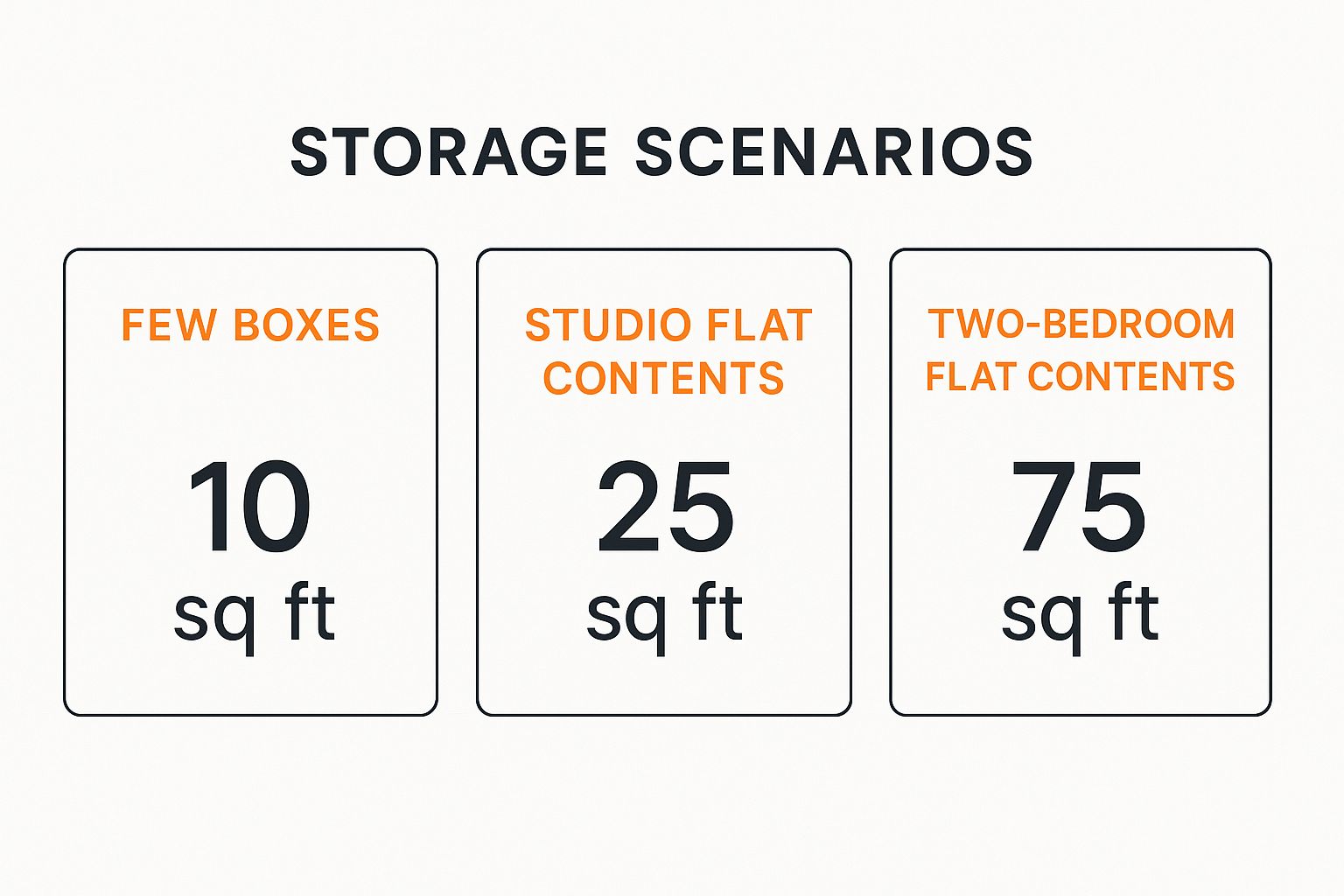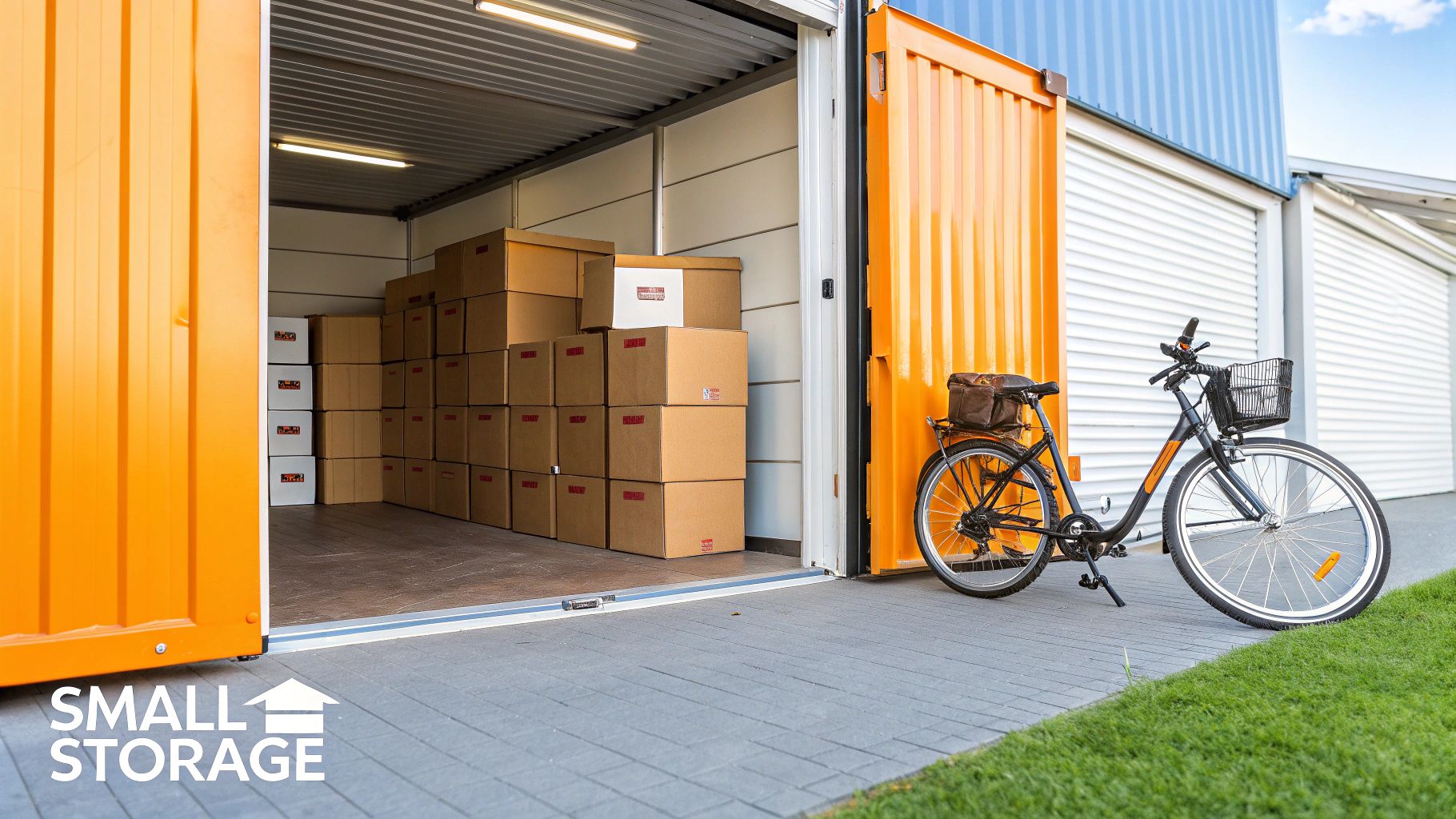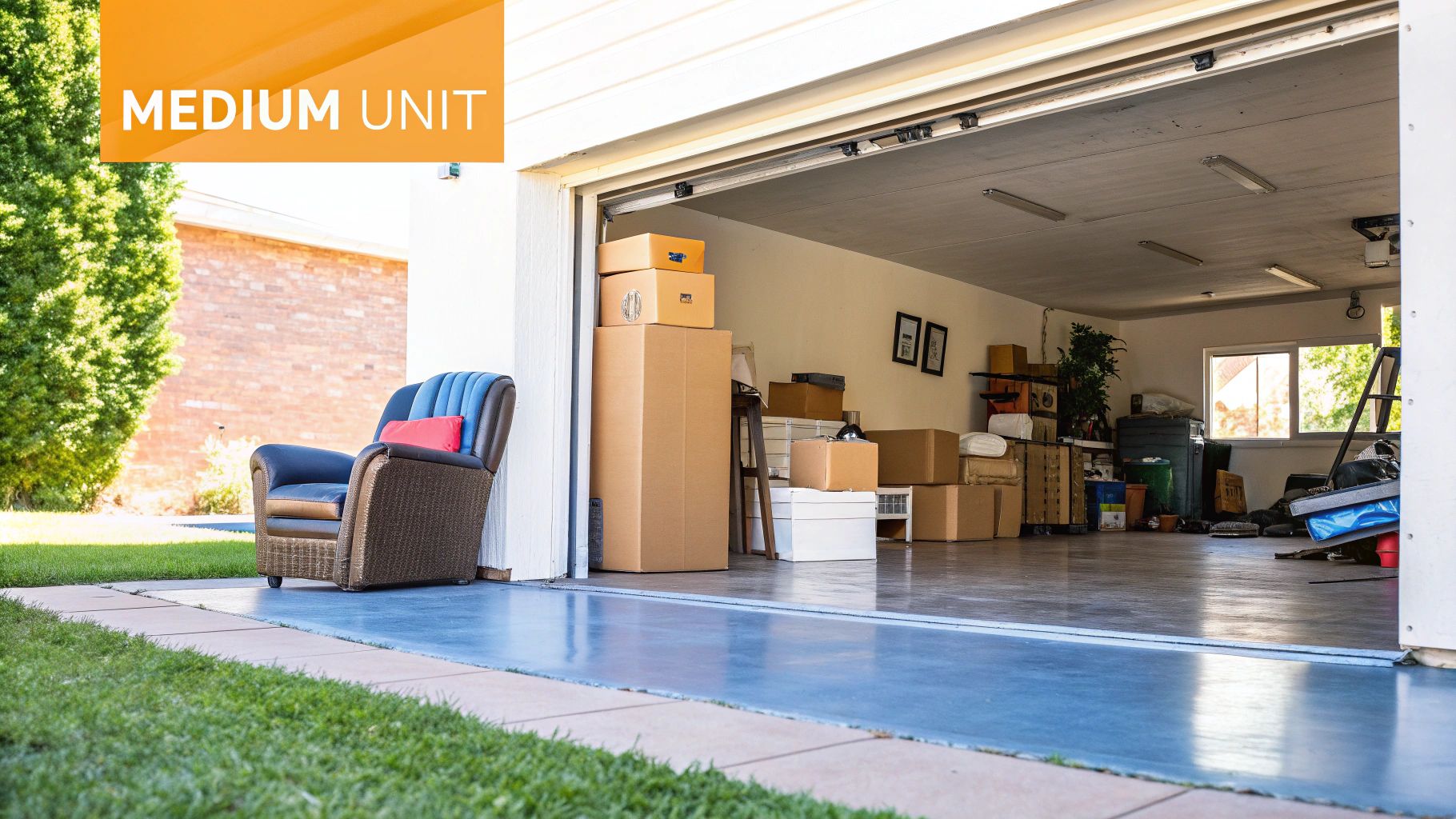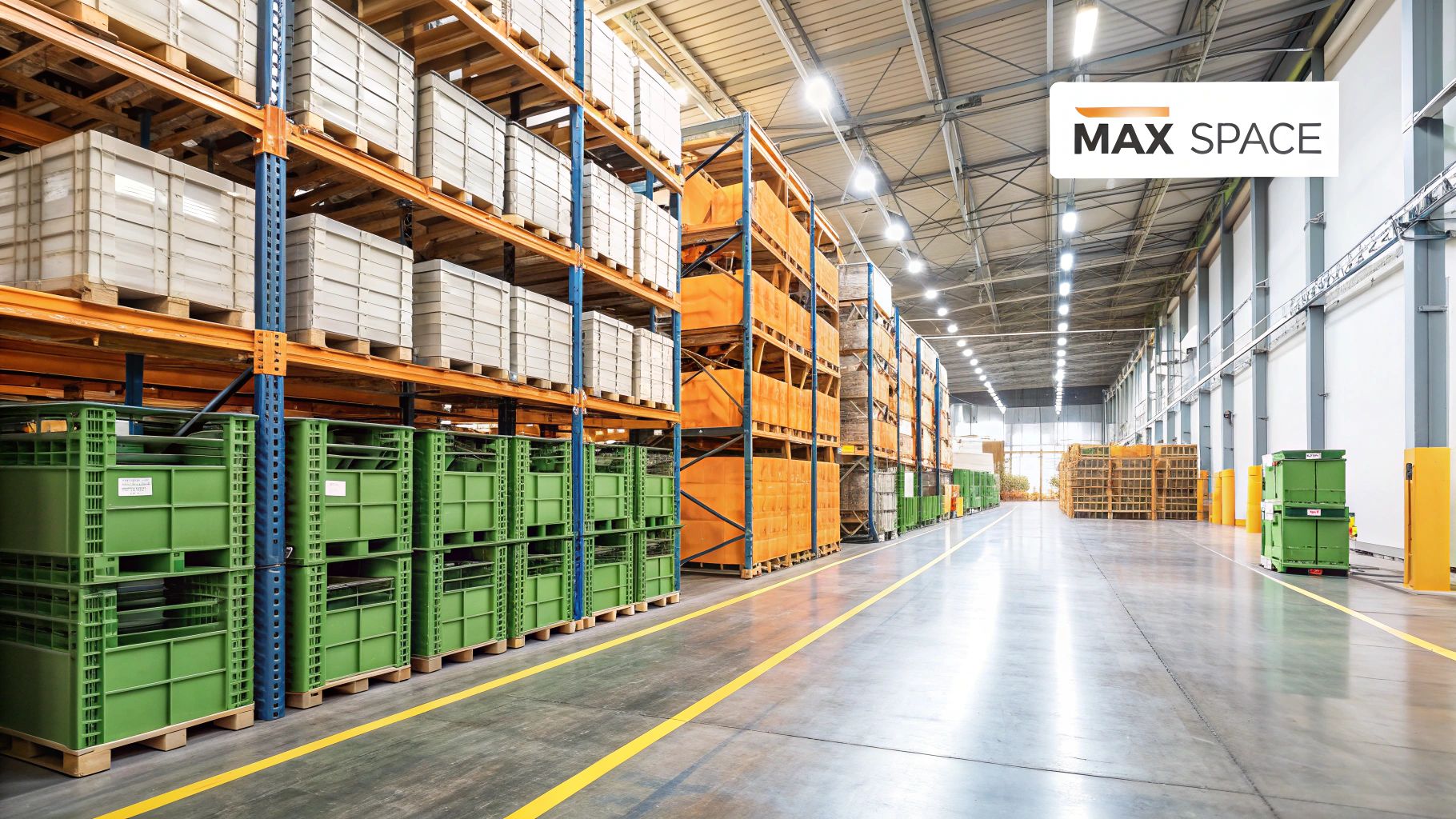Picking the right storage unit can feel like pure guesswork. Staring at a list of dimensions—10 sq ft, 75 sq ft, 150 sq ft—doesn't really help you picture where your stuff will actually fit. But it doesn't have to be so complicated.
This guide is designed to take the maths out of it. We'll help you connect those abstract numbers to real-world spaces you already know, like a garden shed or a single garage. It’s a simple trick that turns a confusing decision into a straightforward one.
How to Instantly Choose the Right Storage Unit
Feeling a bit lost in all the talk of square footage is completely normal when you're looking to rent a storage unit. The secret to making a quick, confident choice is to stop thinking like a mathematician and start thinking visually.
Forget about calculating cubic metres for a moment. Instead, try to picture a familiar space.
Could everything you need to store squeeze into a large garden shed? If so, you're probably looking at a 25 sq ft unit. Or are you packing up the contents of a one-bedroom flat? The image of a standard single-car garage should pop into your head—that's roughly what a 100 sq ft unit feels like. This mental shortcut is hands-down the fastest way to get a ballpark idea and avoid paying for space you simply don't need.
Matching Your Needs to the Right Size
The goal is to find that perfect sweet spot: a unit with enough room for all your belongings, but not so much that you're paying for empty air. When you link unit sizes to everyday scenarios, you can make a pretty solid guess right from the get-go.
This infographic gives a great at-a-glance summary of common storage situations and the unit sizes that match up.
As you can see, a few boxes will be right at home in a tiny 10 sq ft unit, whereas the entire contents of a two-bedroom flat would be a much better fit for a 75 sq ft space.
It’s a bit like how people look for strategies for optimizing your storage on their computers; choosing the right physical unit requires the same kind of smart planning. If you want to get even more precise, it’s worth exploring a detailed breakdown of what fits where. For a really thorough look, check out our complete guide on https://www.standbyselfstorage.co.uk/how-much-storage-space-do-i-need/ to make sure you get the perfect fit.
To help you quickly connect your needs to the right unit, here’s a simple table that matches common scenarios with the best storage size.
Quick Guide to Matching Needs with Storage Unit Sizes
| Unit Size (sq ft) | Common Analogy | Ideal For Storing | Typical Use Case |
|---|---|---|---|
| 10 – 25 | Large Cupboard or Garden Shed | A few boxes, seasonal items, small furniture like a desk or chair. | Storing student belongings over summer, decluttering a spare room. |
| 35 – 50 | Walk-in Wardrobe or Box Room | Contents of a studio flat, including a sofa, mattress, and boxes. | Moving out of a small flat, temporary storage during a renovation. |
| 75 – 100 | Single Garage | Contents of a 1-2 bedroom flat, including appliances and bulky furniture. | Moving house, storing items between property completions. |
| 125 – 200+ | Large Garage or Small Warehouse | Contents of a 3-4 bedroom house, business stock, or large equipment. | Storing the entire contents of a family home, commercial inventory. |
This table should give you a solid starting point. By comparing what you have to these common examples, you can narrow down your options in no time.
Key Takeaway: Don't get bogged down by complex measurements. The most effective first step is to match your storage needs to a familiar analogy—a wardrobe for small jobs, a box room for a studio flat, or a garage for a house move. This simple visualisation trick demystifies the process and sets you on the right path instantly.
Thinking this way strips the stress out of the decision. It lets you choose a unit size with confidence, knowing you have enough room for everything without wasting money.
Visualising Small Storage Units
Small-scale storage is the perfect answer when you're dealing with just a few items, a student's belongings for the summer, or the contents of a small flat. These units, usually ranging from 10 to 50 square feet, offer a brilliant, cost-effective way to clear out the clutter without paying for space you simply don't need.
The real challenge, though, is figuring out what "50 square feet" actually looks like when filled with your belongings. To make the right choice, it helps to think beyond the numbers and picture these spaces in terms you're already familiar with.
The 10 to 25 Sq Ft Unit: The Digital Attic
Picture a 25 sq ft storage unit as a large walk-in wardrobe or a standard garden shed. It’s the ideal size for those things you can’t bear to part with but don’t need cluttering up your home day-to-day. This makes it a go-to option for students storing their things between terms or for homeowners trying to reclaim a spare room.
This size is incredibly versatile. It’s not just for boxes; you can comfortably fit smaller pieces of furniture right alongside your packed-up items. Imagine freeing up an entire room at home just by moving things into a space no bigger than a generous wardrobe.
To give you a clearer idea, here’s what you could typically fit into a 25 sq ft unit:
- A double mattress and box spring.
- A small desk and chair.
- Around 10-15 medium-sized boxes.
- Seasonal items like bulky winter coats or summer sports gear.
- Lamps, mirrors, and small electricals.
This compact space is perfect for decluttering projects, giving you that much-needed breathing room at home. It’s a simple, straightforward solution for storing sentimental items, out-of-season clothing, or hobby equipment.
The 35 to 50 Sq Ft Unit: The Studio Flat Solution
Stepping up to a 35 or 50 sq ft unit is like having an extra box room at your disposal. This size is a real game-changer for anyone moving out of a studio or a small one-bedroom flat, offering enough room for your essential furniture without feeling cramped.
A 50 sq ft unit can comfortably hold the contents of a typical studio flat, minus any particularly bulky appliances. This makes it a popular choice during a house move or a home renovation when you need to clear a room out completely.
Expert Insight: The secret to getting the most out of smaller units is using the vertical space. Most of our units have ceilings around 8 feet high, so stacking sturdy, well-packed boxes is essential. This one trick can nearly double your usable storage area.
Maximising this space is all about smart organisation. To truly get the most out of every square foot, it pays to plan ahead. Our detailed article offers some fantastic advice on how to pack your storage unit a step-by-step guide, ensuring you can fit far more than you might think.
Here's a practical checklist of what you could store in a 50 sq ft unit:
- Living Room: A two-seater sofa, a coffee table, and an entertainment centre.
- Bedroom: A double bed frame and mattress, a chest of drawers, and two bedside tables.
- Boxes: Approximately 20-30 boxes of various sizes, filled with clothes, books, and kitchenware.
- Miscellaneous: Bicycles, sports equipment, and other awkwardly shaped items.
This size strikes a perfect balance, offering a substantial amount of room while remaining an affordable option. By mentally packing the unit with this checklist, you can stop guessing and rent with confidence, knowing you've chosen a space that perfectly suits your needs.
Finding Space for Life's Changes with Medium Units
As life's big moments unfold—moving house, tackling a major renovation, or welcoming a new family member—your home can suddenly feel a lot smaller. This is where medium-sized storage units, ranging from 75 to 125 square feet, truly shine. They're the workhorses of the storage world, perfectly designed to handle these transitions and give you some much-needed breathing room.
These units masterfully bridge the gap between clearing out a single room and packing up an entire household. They're particularly popular with families navigating the temporary chaos of home improvements or individuals caught between properties. The space they offer is substantial enough to hold entire rooms of furniture, making them a practical and sought-after choice.
This need for flexible space is a growing trend across the country. In 2024, the UK self-storage industry expanded to a massive 64.3 million square feet of floorspace—a 7.2% increase from the previous year. It's clear that more and more people are relying on these solutions during key life events. If you're curious about how the market is changing, you can explore detailed insights into the UK self-storage industry.
The 75 Sq Ft Unit: The Half-Garage Solution
Think of a 75 sq ft unit as roughly half the size of a standard single-car garage. It’s the perfect fit for the entire contents of a well-furnished one-bedroom flat, including all the bulky items that take up the most room. This makes it the go-to option when you're between homes or need to clear out a flat completely.
This size easily swallows large pieces of furniture and major appliances, meaning you don't have to sell or give away cherished items just because of a temporary lack of space.
Here’s a snapshot of what you can typically fit inside a 75 sq ft unit:
- Living Room: A three-seater sofa, armchair, coffee table, and television stand.
- Bedroom: A king-size bed and mattress, a large wardrobe, and a chest of drawers.
- Kitchen: A fridge-freezer, washing machine, and dining table with four chairs.
- Boxes: Approximately 30-40 medium to large boxes.
Real-World Scenario: Imagine a young family in a two-bedroom house decides to build a kitchen extension. A 75 sq ft unit would allow them to safely store their entire kitchen and dining room for the three months of construction, protecting everything from dust and damage while keeping their home liveable.
The 100 Sq Ft Unit: The Standard Garage Equivalent
When you need just a bit more capacity, the 100 sq ft unit is an excellent choice. This space is pretty much equivalent to a typical single-car garage, offering ample room for the contents of an average two-bedroom house. It’s the ideal solution for families moving house or anyone needing to store a significant amount of furniture and personal belongings.
A unit this size gives you enough space to create a small walkway, which is incredibly useful if you think you might need to access certain items while they're in storage. Planning for an aisle from the start makes retrieving a specific box or piece of furniture much easier down the line.
Maximising Your Medium Unit
Getting the most out of a medium-sized unit comes down to smart packing. The secret? Think vertically. Most storage units have high ceilings, often around 8 feet, which represents a huge amount of untapped storage potential.
Follow these strategies to make every square foot count:
- Use Sturdy, Uniform Boxes: Using boxes of the same size makes stacking them high and stable much safer and more efficient. Always place the heaviest boxes at the bottom to create a solid foundation.
- Disassemble Furniture: Take apart bed frames, tables, and bookshelves. This dramatically reduces the floor space they occupy and allows you to store them upright against a wall.
- Create a Floor Plan: Before you start loading, sketch a quick map of where your biggest items will go. Place things you're least likely to need at the back and anything you might want to access near the front.
- Fill Every Gap: Tuck smaller items inside larger ones. Store cushions inside wardrobes, fill empty drawers with clothes, and place books inside empty appliances to use every last inch of available space.
When You Need Maximum Space in a Large Unit
Sometimes, you’re past the point of just clearing out a spare room. When your storage needs are serious, it's time to look at the heavy-lifters of the self-storage world: large units. These spaces, typically starting at 150 square feet and climbing to 300 sq ft or even more, are built for major life events and growing businesses.
Think of them as the solution for storing the entire contents of a four or five-bedroom family home, or for a commercial client who needs significant inventory space. These units aren't just bigger; they open up a whole different scale of possibility.
The 150 Sq Ft Unit: A Garage and a Half
A 150 sq ft unit gives you a substantial amount of room, roughly what you’d get from a standard single garage with a bit extra. It’s the perfect size for stashing the complete contents of a three-bedroom house, including all the bulky furniture, major appliances, and dozens of boxes.
Picture it: you can comfortably fit multiple large furniture sets—sofas, dining tables, bedroom suites—alongside your white goods and even garden equipment. It’s the go-to choice for families in transition, making sure nothing important gets left behind.
A 150 sq ft unit typically holds:
- Contents of a three-bedroom house.
- Major appliances like a washing machine, dryer, and fridge-freezer.
- Bulky furniture including sofas, beds, wardrobes, and dining sets.
- Outdoor gear such as lawnmowers, bicycles, and patio furniture.
- Up to 60 medium-to-large boxes.
The 200 to 300 Sq Ft Unit: For Business and Whole-Home Storage
Once you step up to the 200 to 300 sq ft range, you're looking at a space that’s more like a double garage. These units are absolute powerhouses, ideal for both extensive personal storage and serious commercial needs. They can easily swallow the contents of a four or five-bedroom house, often with enough room left over to park a car, small boat, or work van.
For businesses, these units can be a game-changer. An e-commerce seller can house a huge amount of stock, a tradesperson can secure valuable tools and materials, and a small company can archive years of documents and old equipment. The sheer volume gives you the flexibility to get organised, letting you set up aisles and shelving to keep everything accessible.
Business Focus: Don’t just dump and run. In a unit this big, organisation is everything. Use pallet racking or freestanding shelves to take advantage of the vertical height and create a logical layout. Label everything clearly and maybe even keep a digital inventory to track your stock without having to dig through boxes.
Of course, the availability of these giant units can vary. UK self-storage facilities adapt to local demand; a smaller rural site might have 50 to 200 units, while a huge urban centre could boast over 1,000, often in multi-storey buildings. The average facility size is around 25,000 square feet, which usually means a healthy mix of options.
For businesses with truly massive requirements, looking into comprehensive top warehouse storage solutions is the next logical step to optimise space and efficiency. For most, however, these larger units offer a scalable and affordable alternative to leasing a full commercial warehouse, giving you top-notch security and flexibility without the long-term commitment.
Essential Factors to Consider Before You Rent
You’ve figured out the perfect size, which is a massive step forward, but you’re not quite at the finish line yet. To make sure your belongings are safe, easy to get to, and kept in great condition, you need to look beyond the square footage and think about the finer details of the storage facility itself. Honestly, these factors can make all the difference between a great experience and a frustrating one.
Thinking about these things now will save you a world of headaches later on. The goal isn't just to find a unit that’s the right size, but one that’s a perfect fit for your specific items and needs, giving you total peace of mind.
Beyond the Basics: Accessibility and Climate Control
One of the first practical things to think about is accessibility. Will a ground-floor unit with drive-up access make your life easier, especially if you’re lugging heavy furniture or bulky boxes? Or would an upper-level unit, which is often a bit more affordable, work just fine if you’re only storing lighter items? Just ask yourself how often you'll need to get to your things and how much effort you're willing to put in each time.
Next, think about what you’re storing. Standard units are brilliant for most things, but some of your more delicate belongings might need a bit of extra protection.
Key Consideration: If you're storing items that are sensitive to temperature and humidity—like antique wooden furniture, electronics, artwork, or important documents—a climate-controlled unit is non-negotiable. It keeps the environment stable, protecting your valuables from warping, mildew, and corrosion.
Security and Location: The Pillars of a Good Choice
A facility’s security features are absolutely paramount. You're trusting them with your possessions, so you need to feel confident that everything is well-protected. Look for facilities that take a multi-layered approach to security.
Key security features to check for include:
- 24/7 CCTV Monitoring: Continuous surveillance covering the entire property.
- Secure Perimeter Fencing: A solid physical barrier to deter anyone who shouldn’t be there.
- Controlled Gate Access: Systems that require a personal code or keycard to get in.
Location is about more than just how close it is to your house; it also has a big say in cost and what’s available. Regional demand plays a massive role in the self-storage market. For instance, growth isn't even across the UK, with the South East expecting a 6.3% expansion, while areas like Wales are only looking at 0.5% growth. This difference, driven by population density and business activity, directly impacts pricing and your choice of units.
These factors can also affect how much you'll pay. If you want to dive deeper into the numbers, our guide on how much storage costs in the UK offers a detailed breakdown.
Questions to Ask Before You Sign
Before you commit to anything, have a chat with the facility manager. A few well-aimed questions can tell you a lot about the kind of service you can expect.
Here’s a quick checklist to run through:
- What are your exact access hours?
- Can you walk me through all the security measures you have in place?
- Are there any restrictions on what I'm allowed to store here?
- What’s the process if I need to switch to a different size unit down the line?
- Are there any extra fees I should know about?
Asking these questions puts you in the driver’s seat, making sure you can make a fully informed decision. It ensures the facility you choose lines up perfectly with what you need and provides a secure, convenient home for your belongings.
Common Questions About Storage Unit Sizes
Even with all the charts and real-world examples, a few questions might still be nagging at you. That’s perfectly normal. Picking the right storage unit is a big decision, and you want to be completely confident before you commit.
This section is all about tackling those common, practical questions that pop up right at the end. We'll give you clear, straightforward answers to help you finalise your plans without any second-guessing.
What Is the Biggest Mistake People Make When Choosing a Size?
Hands down, the single most common slip-up is underestimating how much space you actually need. It’s so easy to picture all your belongings fitting together perfectly like a game of Tetris, but that mental image almost always leaves out one critical detail: room to move.
People forget to factor in aisles or walkways. Without a clear path, you won't be able to grab that one box tucked away at the back without unpacking the entire unit. A quick visit suddenly turns into a major, frustrating chore.
A good rule of thumb is to rent a unit that feels just a little bigger than you think you’ll need. This extra buffer zone gives you some breathing room and a few key advantages:
- Stress-Free Packing: You won’t feel the pressure to cram everything in, which reduces the risk of accidentally damaging your belongings.
- Easy Access: It lets you create a small aisle, making it a breeze to retrieve specific items later on.
- Future Flexibility: It gives you a bit of wiggle room for any other bits and pieces you might need to store down the line.
Here’s a great trick to try before you commit: use masking tape to mark out the unit's dimensions on your living room or garage floor. This simple hack gives you a much better real-world feel for the space than just looking at numbers on a screen.
Do I Really Need a Climate-Controlled Unit?
That’s a fantastic question, and the answer really boils down to what you’re planning to store. For a lot of household goods, a standard unit offers more than enough protection. But for certain sensitive items, climate control is a very wise investment.
A climate-controlled unit keeps the temperature and humidity levels stable, shielding your items from the damaging effects of extreme heat, cold, or damp. This is especially important here in the UK, where the weather can be so unpredictable.
Think seriously about opting for climate control if you are storing:
- Wooden Furniture: Prevents wood from warping, cracking, or splitting as temperatures fluctuate.
- Electronics: Protects delicate circuitry from condensation and the damaging effects of extreme cold.
- Artwork and Photographs: Guards against fading, mildew, and paper becoming brittle.
- Important Documents: Stops paper from degrading or being ruined by dampness.
- Musical Instruments: Preserves the integrity of wood and strings, which are incredibly sensitive to environmental shifts.
For hardier things like garden tools, plastic tubs filled with clothes, or kitchenware, a standard unit is usually perfectly fine, especially for shorter-term storage. The key is to have a good think about the financial and sentimental value of what you’re storing before you make the final call.
How Do I Calculate the Total Volume I Need?
While square footage tells you about the floor space, it’s cubic footage that reveals the true packing potential of a unit. This number represents the total volume from floor to ceiling, and it's absolutely vital for planning how you'll stack everything.
Calculating it is much simpler than it sounds. Most UK storage units have a standard ceiling height of around 8 feet.
To get the cubic footage, just multiply the unit's square footage by its height. So, a 100 sq ft unit (10ft x 10ft) with an 8ft ceiling gives you 800 cubic feet of usable storage space.
This is where planning your stacking strategy really comes into its own. An easy way to estimate the volume of your own items is to use a standard moving box as a rough guide. A large box is typically around 3-4 cubic feet. By counting up your boxes and adding a guesstimate for your bigger furniture, you can get a surprisingly accurate idea of the total volume you'll need.
Can I Switch to a Different Unit Size Later On?
Absolutely. One of the best things about modern self-storage is the flexibility. Any good facility understands that your storage needs can change. You might sell some furniture, buy new things, or simply realise you picked the wrong size to begin with.
If you find your unit is either too big or too small, switching is usually a very straightforward process.
Here’s how it generally works:
- Get in Touch: Just have a word with the facility manager and explain your situation.
- Check What's Free: They’ll look at what other unit sizes are currently available to rent.
- Arrange the Move: As long as a suitable unit is free, they can sort out the transfer for you.
- Update Your Agreement: Your rental agreement will be adjusted to reflect the new unit size and monthly rate.
This is a really common request, so you should never feel awkward about asking. It's always smart to confirm the facility's specific transfer policy before signing your initial agreement, just for complete peace of mind.
At Standby Self Storage, we make finding the perfect unit simple and stress-free. With our clear size guides and flexible terms, you can book with confidence and manage everything online. Find your ideal storage unit today!





